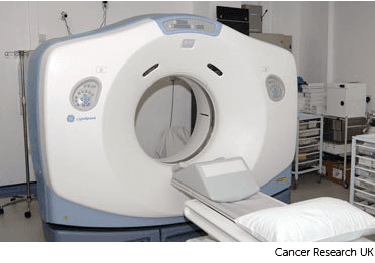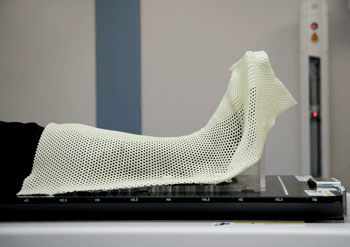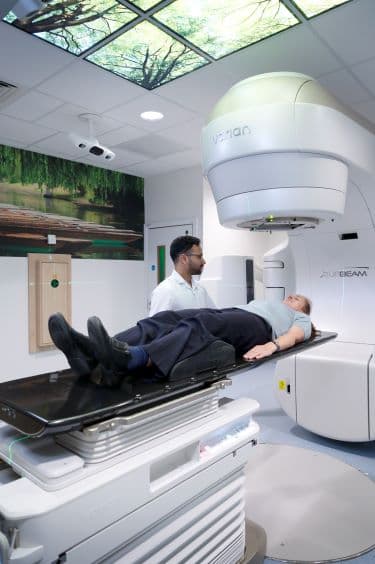Treatment
Radiotherapy treatment works by damaging the within the cancer cells. DNA is the genetic code that controls how the body's cells behave.
You don't routinely have radiotherapy for all types of bone cancer. But it can be an important part of treatment for Ewing sarcoma.
For Ewing sarcoma you might have radiotherapy as your main treatment. Or you might have it before or after surgery.
It is less common to have radiotherapy for other types of bone cancer. But you might have it:
if surgery isn’t possible
after surgery to help lower the risk of the cancer coming back
before surgery to shrink the cancer to help make it easier to remove
to help control the cancer and relieve symptoms
Find out more about the different types of bone cancer
You have external radiotherapy for bone cancer. External radiotherapy uses a machine from outside of the body. It directs radiation beams at the cancer to destroy it.
This is different to internal radiotherapy which means giving radiotherapy to the cancer from inside the body.
The type of external radiotherapy you have depends on the:
type of cancer you have
where it is
how far it has grown or spread (the stage)
the treatment you have already had
your general health
Conformal radiotherapy shapes the radiation beams to closely fit the area of cancer. It is also called 3D conformal radiotherapy or 3DCRT. It is a very common type of radiotherapy.
Find out more about conformal radiotherapy
IMRT shapes the radiotherapy beam to fit the shape of the tumour very accurately. It delivers different amounts of radiation to different parts of the treatment area. This allows higher doses of radiation to treat the area. The surrounding healthy tissues get less radiation.
SBRT gives radiotherapy from many different angles around the body. The beams meet at the tumour. This means the tumour receives a high dose of radiation and the tissues around it receive a much lower dose. This lowers the risk of side effects.
This type of radiotherapy is mainly used to treat very small cancers such as bone cancer that has spread to the lung.
Proton bean therapy radiotherapy uses high energy or low energy proton beams to treat cancer. For bone cancer you have high energy proton beams. This type of radiotherapy uses protons which are small parts of atoms, instead of using high energy x-rays (photons).
You might have this type of radiotherapy for Ewing sarcoma, chordoma and chondrosarcomas.
Find out more about proton beam therapy
You have radiotherapy as a series of daily treatment sessions. A single dose of radiotherapy is called a fraction. A series of sessions makes up a radiotherapy course. You usually have a fraction every day, from Monday to Friday, with a rest at the weekend.
The number of fractions you need depends on your individual situation. A course of radiotherapy may be 1 week or it can be as long as 8 weeks. Your doctor will explain how long you will have radiotherapy for.
Radiotherapy to relieve cancer symptoms such as pain is called palliative radiotherapy. You often have this in fewer fractions. Sometimes it is just one treatment. Palliative radiotherapy has fewer side effects. Your doctor will discuss with you how many sessions you need.
Before you begin your treatment, the radiotherapy team carefully plan your external beam radiotherapy. This means working out how much radiation you need to treat the cancer and exactly where you need it.
Your planning appointment may take from 15 minutes to 2 hours. You usually have a planning CT scan in the radiotherapy department.
The scan shows the cancer and the area around it. You might have other types of scans or x-rays to help your treatment team plan your radiotherapy. The plan they create is just for you.

Your radiographers tell you what is going to happen. They help you into position on the scan couch.
The CT scanner couch is the same type of bed that you lie on for your treatment sessions. You need to lie very still. Tell your radiographers if you aren't comfortable.
You might need an injection of dye (contrast) into a vein. This is through a small tube that goes into the back of your hand. It’s called a cannula. The contrast helps body tissues show up more clearly on the scan.
Before you have the contrast, your radiographer asks you about any medical conditions or allergies. Some people are allergic to the contrast.
Once you are in position your radiographers put some markers on your skin. They move the couch up and through the scanner. They then leave the room and the scan starts.
The scan takes about 5 minutes. You won't feel anything. Your radiographers can see and hear you from the CT control area where they operate the scanner.
The radiographers make pin point sized tattoo marks on your skin. They use these marks to line you up into the same position every day. The tattoos make sure they treat exactly the same area for all of your treatments. They may also draw marks around the tattoos with a permanent ink pen, so that they are clear to see when the lights are low.

The radiotherapy staff tell you how to look after the markings. The pen marks might start to rub off in time, but the tattoos won’t. Tell your radiographer if that happens. Don't try to redraw them yourself.
Your treatment team might make a plastic mould or mask for you. This is also called a shell. This is to keep your arm or leg still during the treatment sessions. This is so your treatment will be as accurate as possible.

Most types are made of a mesh material with lots of small holes. You can have a mould for other parts of the body, such as the chest, head or neck.
You wear the mould or mask for each treatment session. The radiographers might make marks on it. They use the marks to line up the radiotherapy machine for each treatment.
Go to information about radiotherapy masks and moulds
A vacuum bag mould is used during your treatment to help keep you still and in the right position.
Your radiographer might make a mould using a plastic cushion filled with tiny polystyrene balls.
They mould the cushion around the treatment area and then suck out the air with a vacuum pump.
This moulds the cushion very closely around your body and the radiographer removes the pump. The cushion then forms a solid and firm support each time you have treatment. The cushion is called a vac pac.
You might have to wait a few days or weeks before you start treatment.
During this time the physicists and your radiotherapy doctor (clinical oncologist) decide the final details of your radiotherapy plan. They make sure that the area of the cancer will receive a high dose and nearby areas receive a low dose. This lowers the side effects you might get during and after treatment.
Read more about radiotherapy planning
Radiotherapy machines are very big and could make you feel nervous when you see them for the first time. The machine might be fixed in one position. Or it might rotate around your body to give treatment from different directions. The machine doesn't touch you at any point.
Before your first treatment, your will explain what you will see and hear. In some departments, the treatment rooms have docks for you to plug in music players. So you can listen to your own music while you have treatment.

The radiographers help you to get onto the treatment couch. You will be in the same position that you were in for the planning appointment. If they used a plastic shell at the planning appointment then they will use this again.
The radiographers line up the radiotherapy machine using the marks on your body. Once you are in the right position, they leave the room.
You need to lie very still. Your radiographers might take images (x-rays or scans) before your treatment to make sure that you're in the right position. The machine makes whirring and beeping sounds. You won’t feel anything when you have the treatment.
Your radiographers can see and hear you on a CCTV screen in the next room. They can talk to you over an intercom and might ask you to hold your breath or take shallow breaths at times. You can also talk to them through the intercom or raise your hand if you need to stop or if you're uncomfortable.
This treatment doesn't make you radioactive. You can have visitors while you are in hospital.
You might have to travel a long way each day for your radiotherapy. This depends on where your nearest cancer centre is. This can make you very tired, especially if you have side effects from the treatment.
You can ask your radiographers for an appointment time to suit you. They will do their best, but some departments might be very busy. Some radiotherapy departments are open from 7 am till 9 pm.
Car parking can be difficult at hospitals. Ask the radiotherapy staff if you are able to get free parking or discounted parking. They may be able to give you tips on free places to park nearby.
Hospital transport may be available if you have no other way to get to the hospital. But it might not always be at convenient times. It is usually for people who struggle to use public transport. Or who have any other illnesses or disabilities. You might need to arrange hospital transport yourself.
Some people are able to claim back a refund for healthcare travel costs. This is based on the type of appointment and whether you claim certain benefits. Ask the radiotherapy staff for more information about this and hospital transport.
Some hospitals have their own drivers and local charities might offer hospital transport. So do ask if any help is available in your area.
Radiotherapy for bone cancer can cause side effects, but knowing what to expect can help you to cope with them.
The side effects you get will depend on:
where you are having treatment to
how much radiotherapy you have (the number or fractions and overall dose)
if you have it with other treatments such as chemotherapy
Some of the side effects can include:
reddening or darkening of your skin in the treatment area
loss of any body hair in the treatment area
tiredness and weakness
feeling or being sick
diarrhoea
The following video talks about the general side effects of radiotherapy. This video is around 8 minutes.
Last reviewed: 07 Apr 2025
Next review due: 07 Apr 2028
The main treatments for cancer that starts in your bone (primary bone cancer) include surgery, chemotherapy and radiotherapy.
Your radiotherapy treatment plan is individual to you. You have a CT scan or MRI scan, to create your radiotherapy plan.
External radiotherapy targets radiation at the cancer from a radiotherapy machine. Read about types of external radiotherapy and what happens during planning.
Radiotherapy can cause different side effects depending on which part of the body is being treated. Find out what these side effects are and how they affect you during and after treatment.
The main treatments for cancer that starts in your bone include surgery, chemotherapy and radiotherapy. You might have a combination of these treatments. Find out more.
Primary bone cancer is cancer that has started in any bone of your body.

About Cancer generously supported by Dangoor Education since 2010. Learn more about Dangoor Education
Search our clinical trials database for all cancer trials and studies recruiting in the UK.
Meet and chat to other cancer people affected by cancer.
Questions about cancer? Call freephone 0808 800 40 40 from 9 to 5 - Monday to Friday. Alternatively, you can email us.